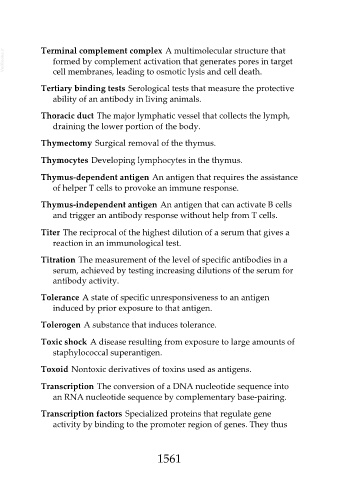Page 1561 - Veterinary Immunology, 10th Edition
P. 1561
VetBooks.ir Terminal complement complex A multimolecular structure that
formed by complement activation that generates pores in target
cell membranes, leading to osmotic lysis and cell death.
Tertiary binding tests Serological tests that measure the protective
ability of an antibody in living animals.
Thoracic duct The major lymphatic vessel that collects the lymph,
draining the lower portion of the body.
Thymectomy Surgical removal of the thymus.
Thymocytes Developing lymphocytes in the thymus.
Thymus-dependent antigen An antigen that requires the assistance
of helper T cells to provoke an immune response.
Thymus-independent antigen An antigen that can activate B cells
and trigger an antibody response without help from T cells.
Titer The reciprocal of the highest dilution of a serum that gives a
reaction in an immunological test.
Titration The measurement of the level of specific antibodies in a
serum, achieved by testing increasing dilutions of the serum for
antibody activity.
Tolerance A state of specific unresponsiveness to an antigen
induced by prior exposure to that antigen.
Tolerogen A substance that induces tolerance.
Toxic shock A disease resulting from exposure to large amounts of
staphylococcal superantigen.
Toxoid Nontoxic derivatives of toxins used as antigens.
Transcription The conversion of a DNA nucleotide sequence into
an RNA nucleotide sequence by complementary base-pairing.
Transcription factors Specialized proteins that regulate gene
activity by binding to the promoter region of genes. They thus
1561

